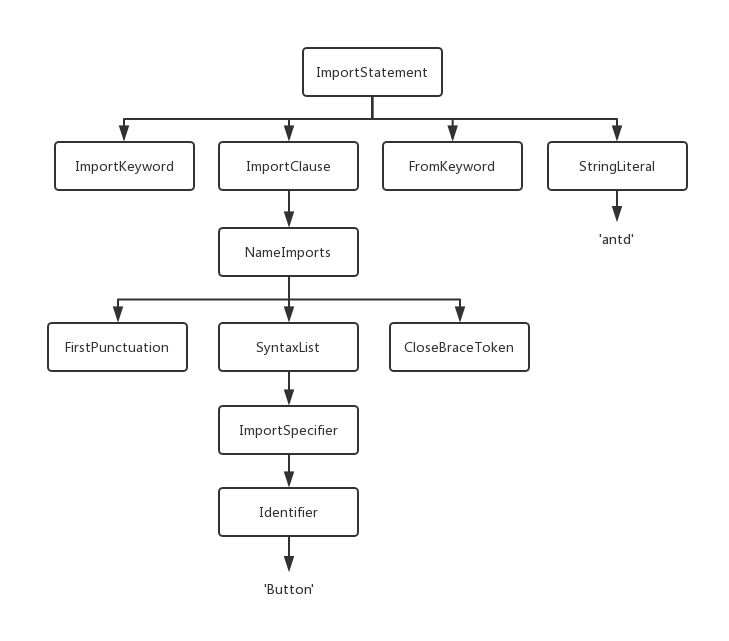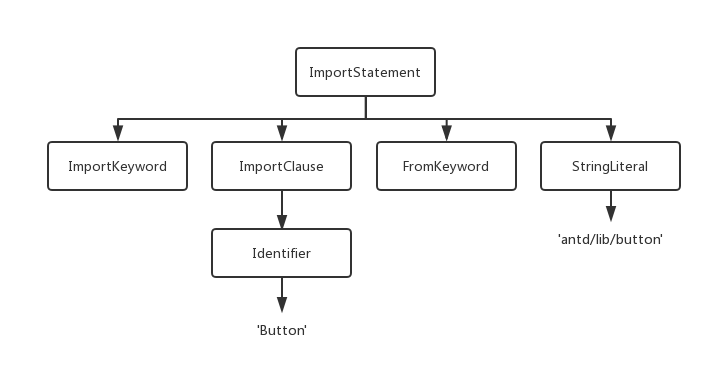# 走进 TypeScript
何镇豪 (opens new window) / 2021-2-8
TypeScript 是 JavaScript 的强类型版本,然后它会在编译器把类型、特有语法等等编译成 JavaScript 。由于最终运行的是 JavaScript ,所以 TypeScript 并不会依赖于浏览器的支持,也不会带来兼容性的问题。
# 类型系统的好处
1. 静态类型检查
静态类型检查可以避免很多不必要的错误, 可以在编译期久发现错误,不用在运行时才发现问题。
2. IDE 智能提示
在没有使用 TypeScript , JavaScript 的智能提示基本完全依赖 IDE 提供的猜测。局限性就是,这种猜测可能并不正确,并且也缺乏更多的辅助信息,所以要正确使用一个类库,得不断地在文档和 IDE 之间切换,影响效率。而 TypeScript 不仅自己写的 JavaScript 有丰富的类型信息,也可以对其他纯 JS 项目进行类型标注 (DefinitelyTyped (opens new window)), 便于使用者直接在 IDE 中浏览 API,效率大增。
3. 可读性
对于阅读代码的人来讲,各种便利的类型一目了然,更容易明白作者的意图。
# 核心
1. 编译
TS 的编译流程包含三步:解析->转换->生成
- Scanner: 从源码生成token
- Parser: 从token生成AST
- Binder: 从AST生成symbol
- Checker: 类型检查
- Emitter: 生成JS

例子:transformer plugin
很多UI库都支持模块的按需引用,比如:
import { Button } from 'antd'
通过 Plugin 转换之后会被转换成:
import Button from 'antd/lib/button'
在一个没有使用全部组件的项目里,这样做可以明显减少打包后的代码体积。
下面是一个简单的 transformer plugin 例子:
通过 AST explorer (opens new window) 可以发现,需要完成上面的转换,只需要进行两处转换,即替换 ImportClause 的子节点和替换 StringLiteral 为原来的值加上上面的 Identifier。
转换前:

转换后:

代码:
import * as ts from 'TypeScript'
import * as kind from 'ts-is-kind'
function transformer(ctx: ts.TransformationContext): ts.Transformer<ts.SourceFile> {
const visitor: ts.Visitor = (node: ts.Node): ts.Node => {
if (kind.isSourceFile(node)) {
return ts.visitEachChild(node, visitor, ctx)
}
if (kind.isImportDeclaration(node)) {
return updateImportNode(node, ctx)
}
return node
}
return (sf: ts.SourceFile) => {
return ts.visitNode(sf, visitor)
}
}
function updateImportNode(node: ts.Node, ctx: ts.TransformationContext): ts.Node {
let identifierName: string
const visitor: ts.Visitor = node => {
if (kind.isNamedImports(node)) {
identifierName = node.getChildAt(1).getText()
return ts.createIdentifier(identifierName)
}
if (kind.isStringLiteral(node)) {
const libName = node.getText().replace(/[\"\']/g, '')
if (identifierName) {
const fileName = camel2Dash(identifierName)
return ts.createLiteral(`${libName}/lib/${fileName}`)
}
}
if (node.getChildCount()) {
return ts.visitEachChild(node, visitor, ctx)
}
return node
}
return ts.visitEachChild(node, visitor, ctx)
}
function camel2Dash(_str: string) {
const str = _str[0].toLowerCase() + _str.substr(1)
return str.replace(/([A-Z])/g, ($1) => `-${$1.toLowerCase()}`)
}
function compile(sourceCode: string) {
const source = ts.createSourceFile(
'',
sourceCode,
ts.ScriptTarget.ES2016,
true
)
const result = ts.transform(source, [transformer])
const transformedSourceFile = result.transformed[0]
const printer = ts.createPrinter()
const resultCode = printer.printFile(transformedSourceFile)
return resultCode
}
// import Button from "antd/lib/button";
console.log(compile('import { Button } from "antd"'))
其实大概思路就是:遍历节点,找到importDeclaration的节点,然后替换更新节点。
2. 类型系统
结构类型
TypeScript 的类型系统是基于结构子类型的,这种类型系统是一种只使用成员来描述类型的方式。它与名义类型正好相反,名义类型是通过明确的声明或类型的名称来决定的。
泛型
- 目的是为了创建可复用的组件,使其可以支持多数据类型。
- 本质就是给类型传参
interface Generic<T> { (x: T, y: T): T; } let add: Generic<number> = function add (x, y) { return x + y } add(1, 12)当我们使用
Generic<number>时,<number>就像是参数1和12一样,方法内的类型也同样可以使用这个类型参数。可以用 extends 来对泛型约束
// 泛型约束 interface Length { length: number } function loggingLength<T extends Length> (arg: T): number { return arg.length }
Type vs Interface
- 不能通过类型别名定义联合类型来实现类
- 接口不能继承用联合类型定义的类型别名
- 类型别名不能声明合并
类型收缩
类型断言
<类型>值 值 as 类型如果需要多处使用断言:
function padLeft(value: string, padding: string | number) { console.log((padding as number) + 3); console.log((padding as number) + 2); console.log((padding as number) + 5); return Array((padding as number) + 1).join(' ') + value; }可以使用类型保护
类型保护
- typeof: 用于判断 "number","string","boolean"或 "symbol" 四种类型
- instanceof : 用于判断一个实例是否属于某个类
- in: 用于判断一个属性/方法是否属于某个对象
- 字面量类型保护
- 自定义类型保护
Never、void、any、unknown
Never是TypeScript的一种
bottom type,即是表示永不存在的值的类型。// 不相交类型的inteserction结果为never type IntersectionNeverType = 1 & 2 // 是任何类型的subtype type Check<T> = never extends T ? true : false type SubTypeCheck = Check<string> // 布尔运算 type result = string | never type result1 = string & nevervoid 当定义函数返回值类型时,表示不返回任何值;定义变量类型时,该变量只能赋值为 undefined/null
unknown 表示未知类型,当无法立刻确定类型时,建议先使用 unknown,到使用时再使用类型断言确定类型
let a: any = 1 const b: unknown = 2; console.log(a.name) // 不会报类型错误 console.log(b.name) // 会报类型错误 console.log((b as {name: string}).name)
内置工具集
# keyof
interface Person { name: string; age: number; } type K1 = keyof Person; // "name" | "age" type K2 = keyof Person[]; // "length" | "toString" | "pop" | "push" | "concat" | "join" type K3 = keyof { [x: string]: Person }; // string | number该操作符可以用于获取某种类型的所有键,其返回类型是联合类型。
# Partial
作用就是将某个类型里的属性全部变为可选项
?/** * node_modules/TypeScript/lib/lib.es5.d.ts * Make all properties in T optional */ type Partial<T> = { [P in keyof T]?: T[P]; };更多内置工具集可以自行查阅官方文档。
装饰器
什么是装饰器?
装饰器是一种特殊的声明,可附加在类、方法、访问器、属性、参数声明上。它可以在不修改代码自身的前提下,给已有代码增加额外的行为。
例子
function f() { console.log("f(): evaluated"); return function (target, propertyKey: string, descriptor: PropertyDescriptor) { console.log("f(): called"); } } function g() { console.log("g(): evaluated"); return function (target, propertyKey: string, descriptor: PropertyDescriptor) { console.log("g(): called"); } } class C { @f() @g() method() {} }结果:
f(): evaluated g(): evaluated g(): called f(): called结论:
- 由上至下依次对装饰器表达式求值。
- 求值的结果会被当作函数,由下至上依次调用。
类装饰器
类的语法糖
class Dog { say() { console.log("汪~"); } }等同于
function Dog() {} Object.defineProperty(Dog.prototype, "say", { value: function() { console.log("汪~"); }, enumerable: false, configurable: true, writable: true });类装饰器
function isAnimal(target) { target.isAnimal = true; return target; } @isAnimal class Dog { ... } console.log(Dog.isAnimal); // true
装饰器求值
- 参数装饰器,然后依次是方法装饰器,访问符装饰器,或属性装饰器应用到每个实例成员。
- 参数装饰器应用到构造函数。
- 类装饰器应用到类。
@Component
大家其实都在 vue2.0 里面用过 TypeScript,都知道通常都会使用 vue-class-component 来配合使用。
而
@Component是最常用的装饰器,通过它的源码可以发现它的核心方法是componentFactory。它做了三件事:
生成 options,通过一些判断来给 options 添加属性
const proto = Component.prototype Object.getOwnPropertyNames(proto).forEach(function (key) { if (key === 'constructor') { return } // hooks if ($internalHooks.indexOf(key) > -1) { options[key] = proto[key] return } const descriptor = Object.getOwnPropertyDescriptor(proto, key)! if (descriptor.value !== void 0) { // methods if (typeof descriptor.value === 'function') { (options.methods || (options.methods = {}))[key] = descriptor.value } else { // TypeScript decorated data (options.mixins || (options.mixins = [])).push({ data (this: Vue) { return { [key]: descriptor.value } } }) } } else if (descriptor.get || descriptor.set) { // computed properties (options.computed || (options.computed = {}))[key] = { get: descriptor.get, set: descriptor.set } } })遍历component里的
__decorator__属性,并执行它的factory方法// decorate options const decorators = (Component as DecoratedClass).__decorators__ if (decorators) { decorators.forEach(fn => fn(options)) delete (Component as DecoratedClass).__decorators__ }调用
Vue.extend(options)创建一个组件构造器并返回const superProto = Object.getPrototypeOf(Component.prototype) const Super = superProto instanceof Vue ? superProto.constructor as VueClass<Vue> : Vue const Extended = Super.extend(options) ... return Extended
# 开发插件
JSON to TS
可以快速完成 JSON 数据到 TS 接口的转换工作。
Document This
可以快速对函数进行注释。
Quokka.js
Quokka 可以在 VS Code 运行 JS/TS 代码,并显示结果。
# 总结
这篇文章只是简单梳理了 TypeScript 的一些重要概念,对于某些概念,还需要自身去官方文档深入研究,以及在实际开发中运用来加深理解。
个人觉得,无论大型还是小型项目,TypeScript 都是必要的。
